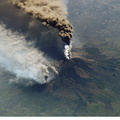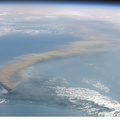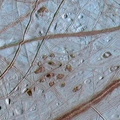
WIKIARCHIVES.SPACE
The Human Spaceflight Archive

Reddish spots and shallow pits pepper the enigmatic ridged surface of Europa in this view combining information from images taken by NASA's Galileo spacecraft during two different orbits around Jupiter.
Information
- Taken in
- Author
- NASA/JPL/University of Arizona/University of Colorado
- Description
-
Reddish spots and shallow pits pepper the enigmatic ridged surface of Europa in this view combining information from images taken by NASA's Galileo spacecraft during two different orbits around Jupiter.
The spots and pits visible in this region of Europa's northern hemisphere are each about 10 kilometers (6 miles) across. The dark spots are called "lenticulae," the Latin term for freckles. Their similar sizes and spacing suggest that Europa's icy shell may be churning away like a lava lamp, with warmer ice moving upward from the bottom of the ice shell while colder ice near the surface sinks downward. Other evidence has shown that Europa likely has a deep melted ocean under its icy shell. Ruddy ice erupting onto the surface to form the lenticulae may hold clues to the composition of the ocean and to whether it could support life.
The image combines higher-resolution information obtained when Galileo flew near Europa on May 31, 1998, during the spacecraft's 15th orbit of Jupiter, with lower-resolution color information obtained on June 28, 1996, during Galileo's first orbit.
- Created on
- Wednesday 30 October 2002
- Albums
- US SPACE PROGRAM / PROBES / JUPITER / GALILEO / Mission Photos (Edited) / JUPITER / EUROPA
- Source link
- https://photojournal.jpl.nasa.gov
- Visits
- 9
- Rating score
- no rate
- Rate this photo
- License
- Public Domain
- Modified by WikiArchives
- No (original)
- Downloads
- 0
Powered by Piwigo


